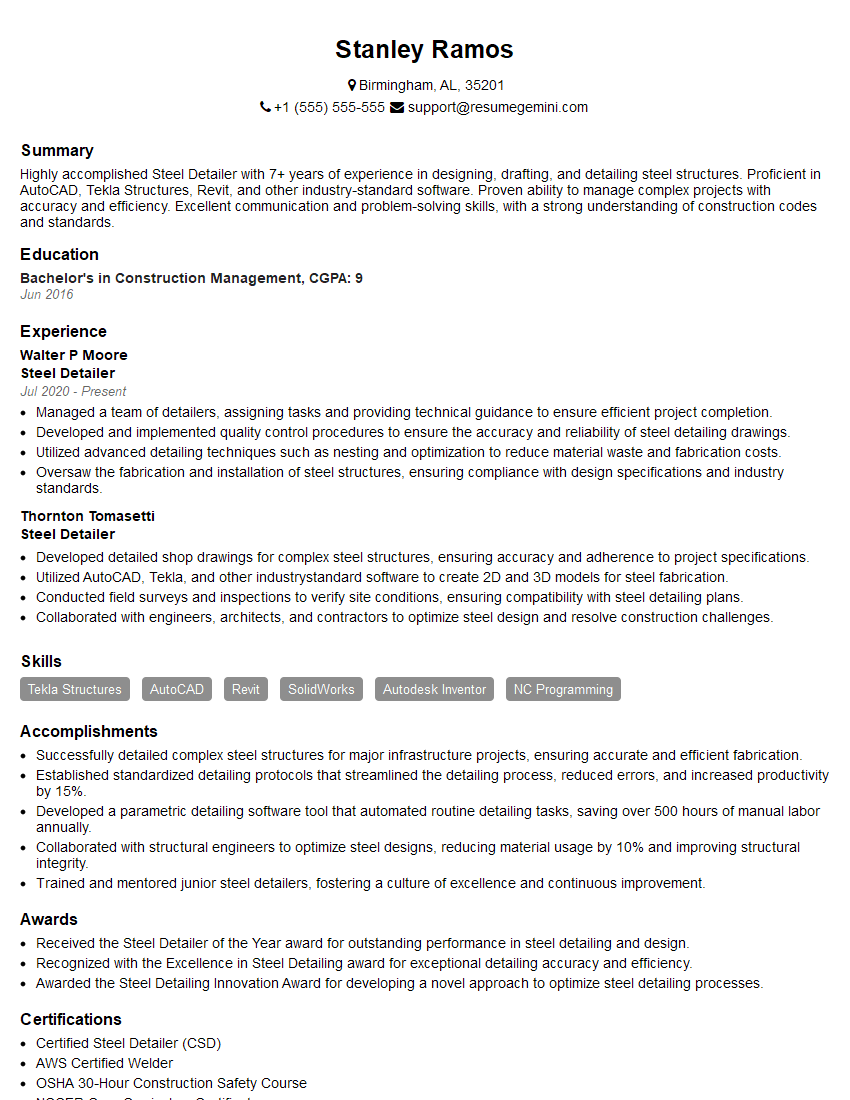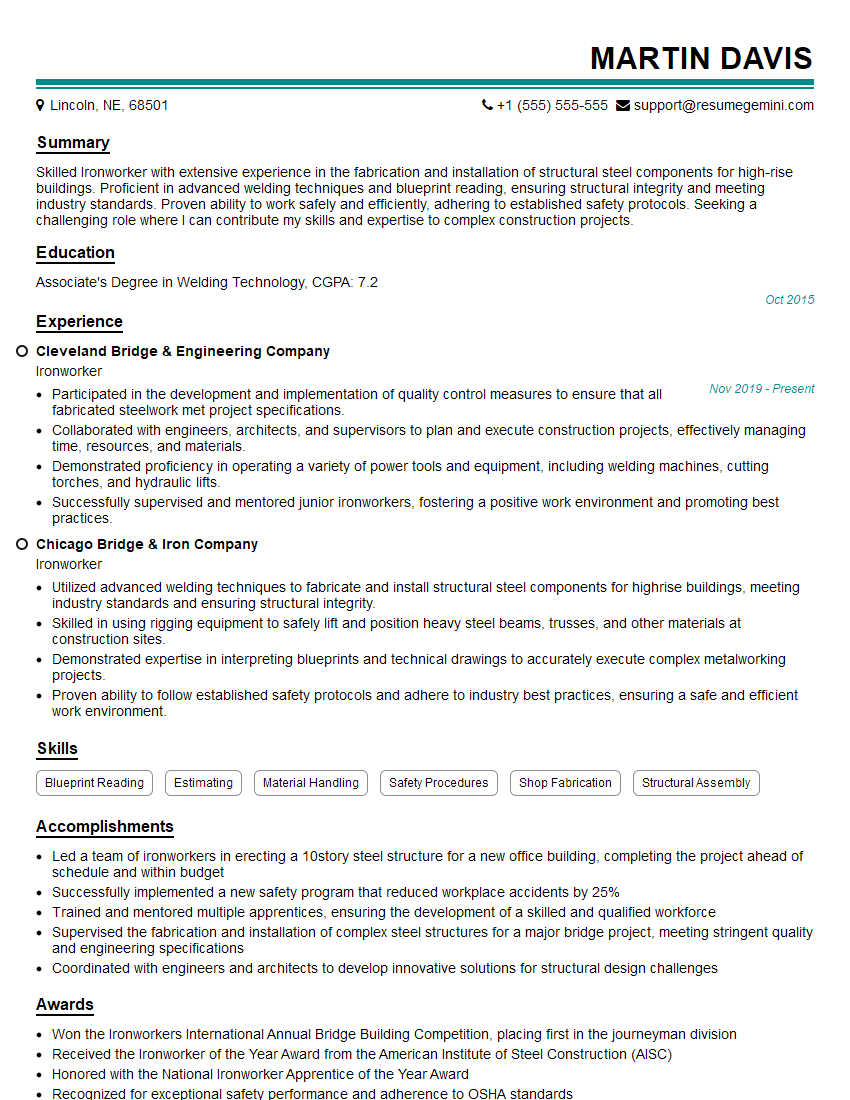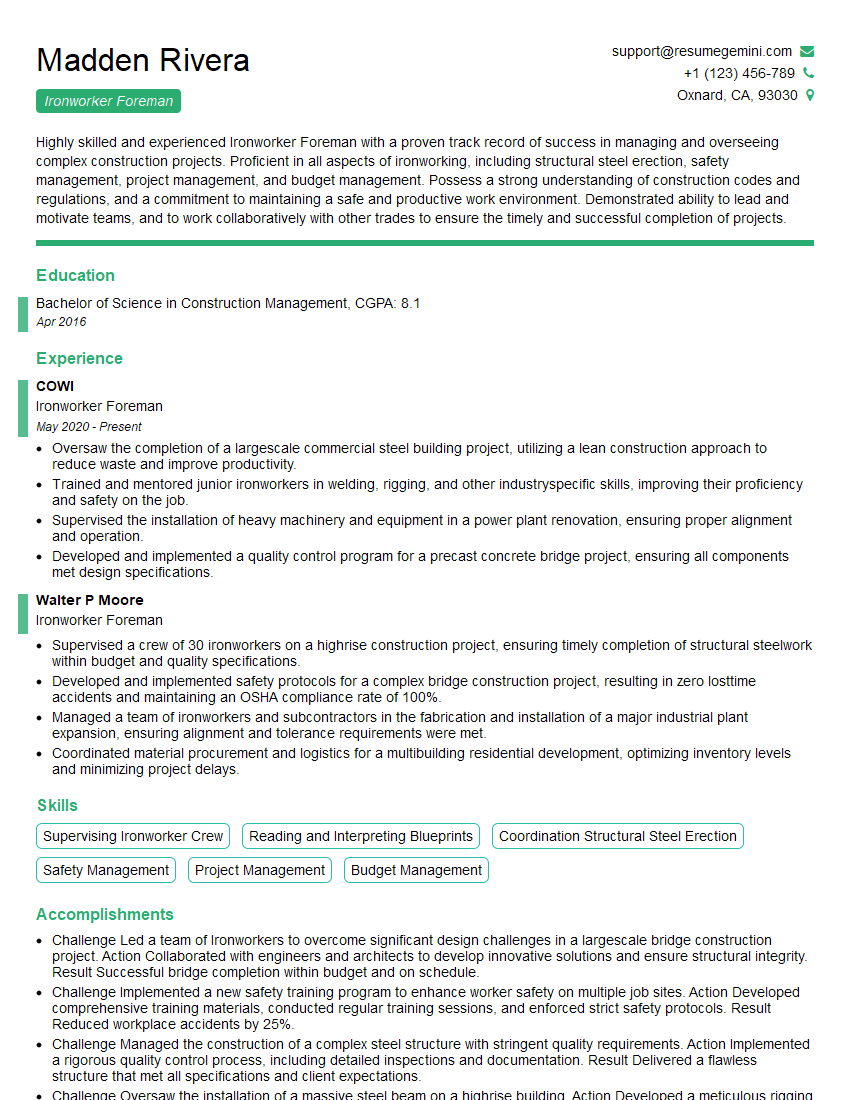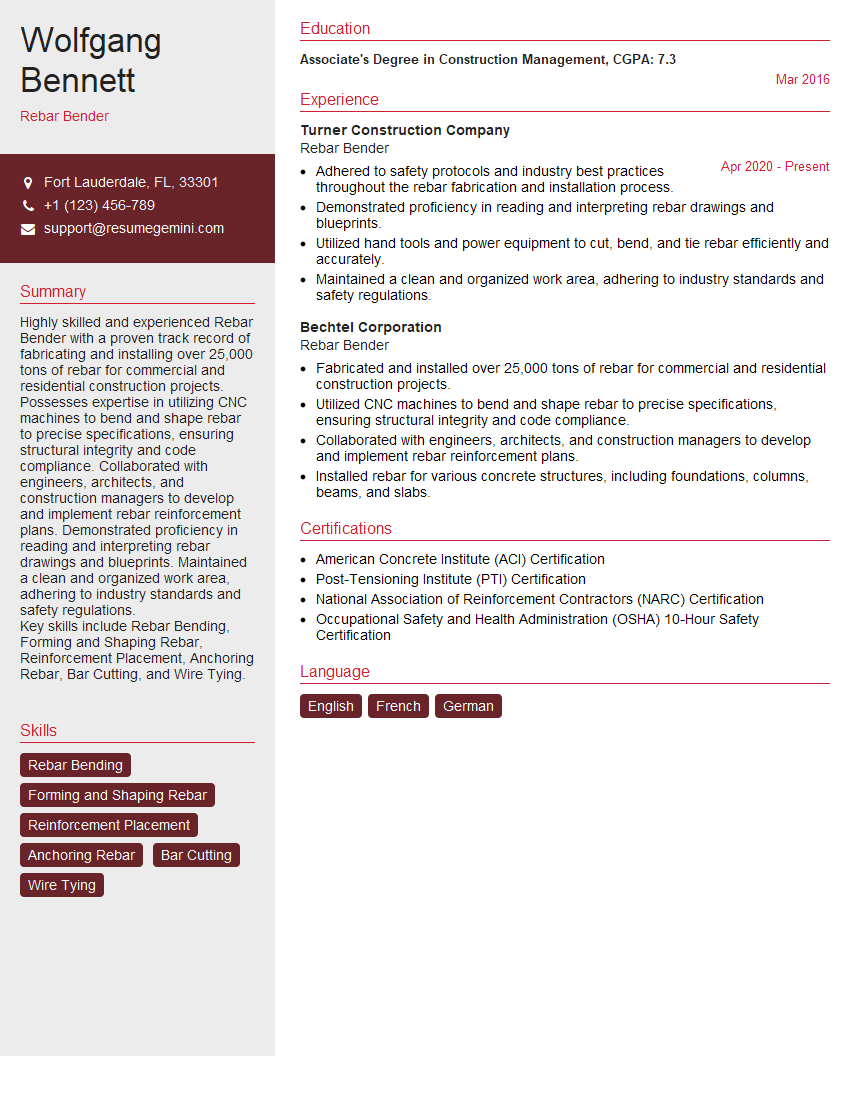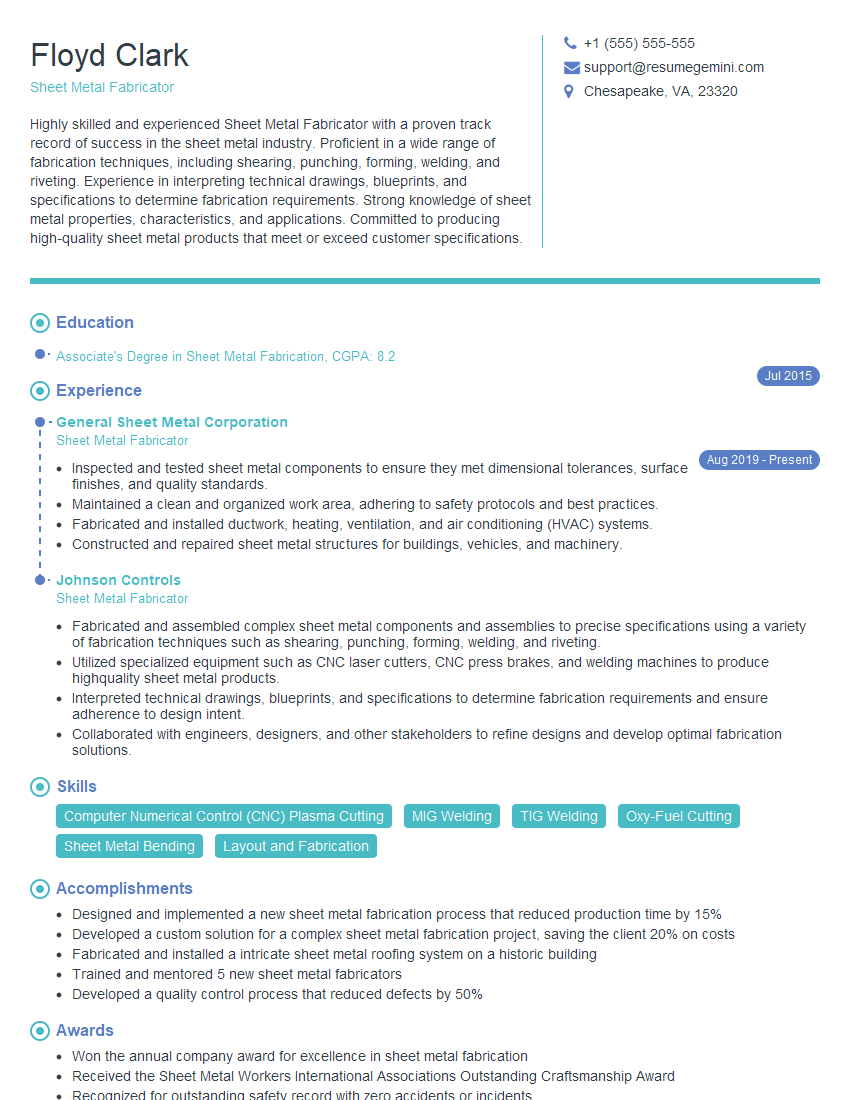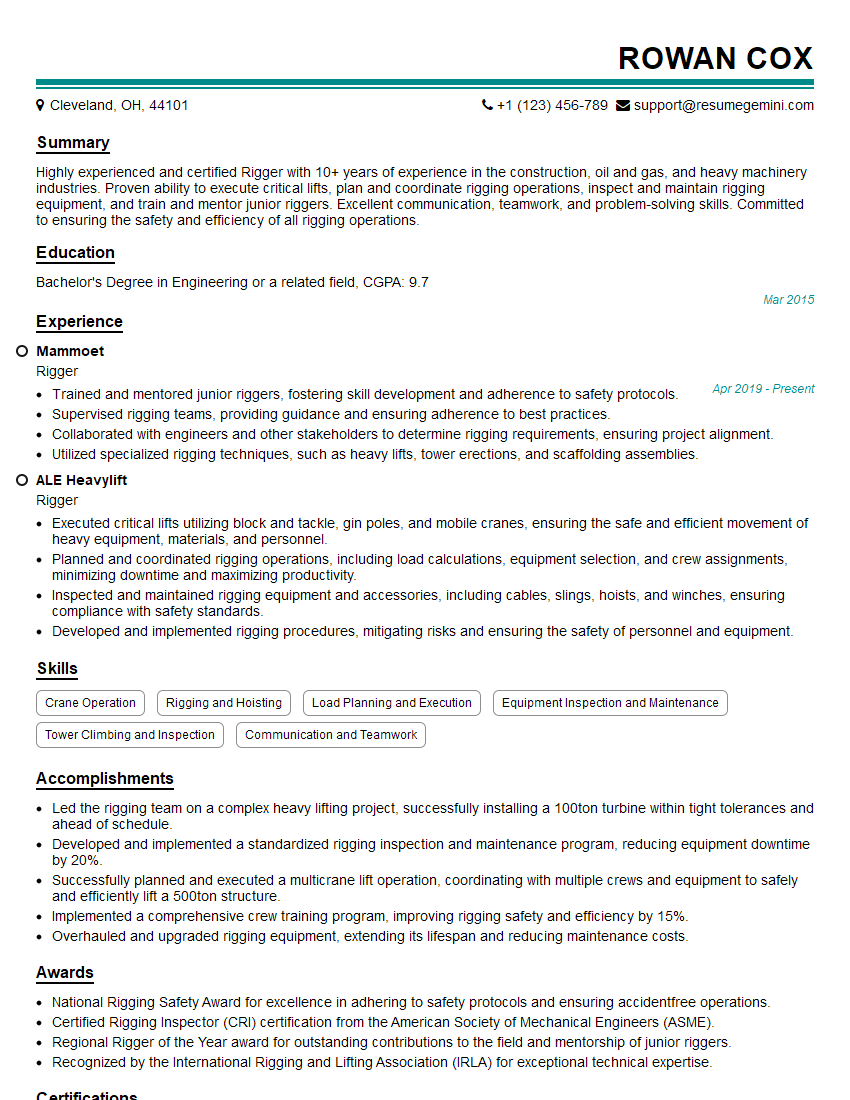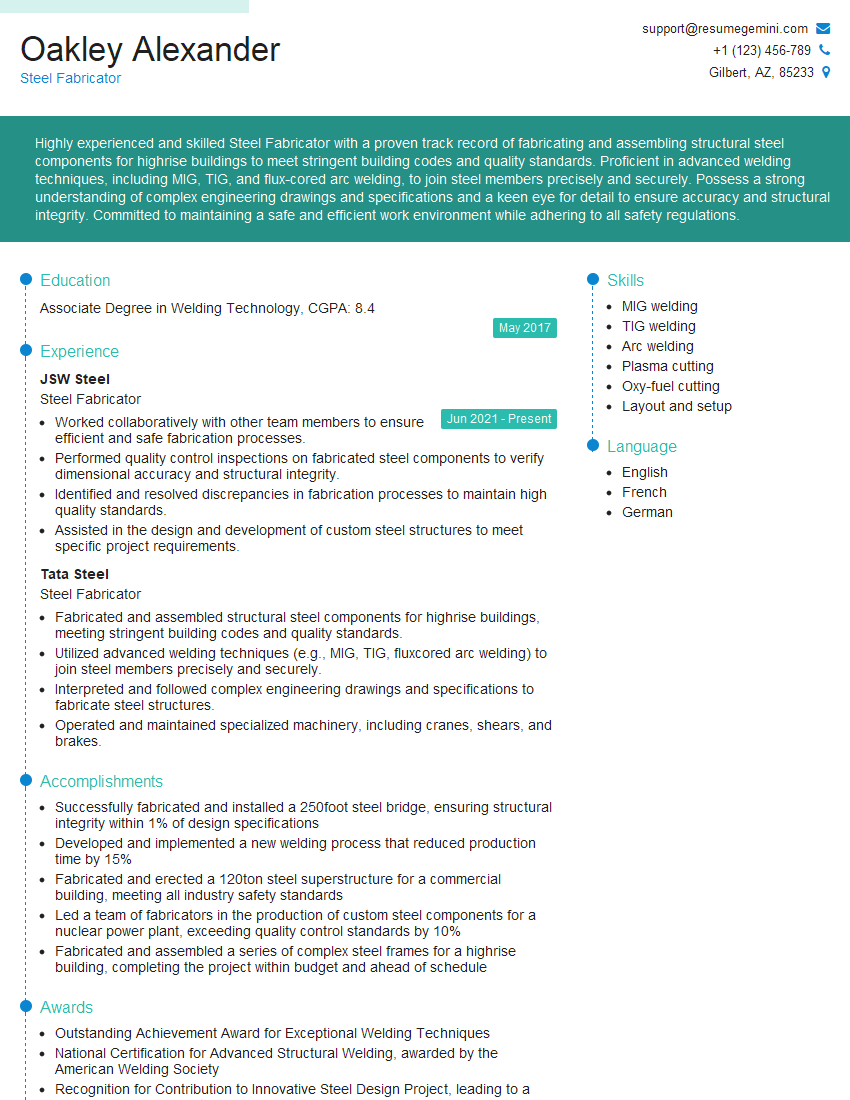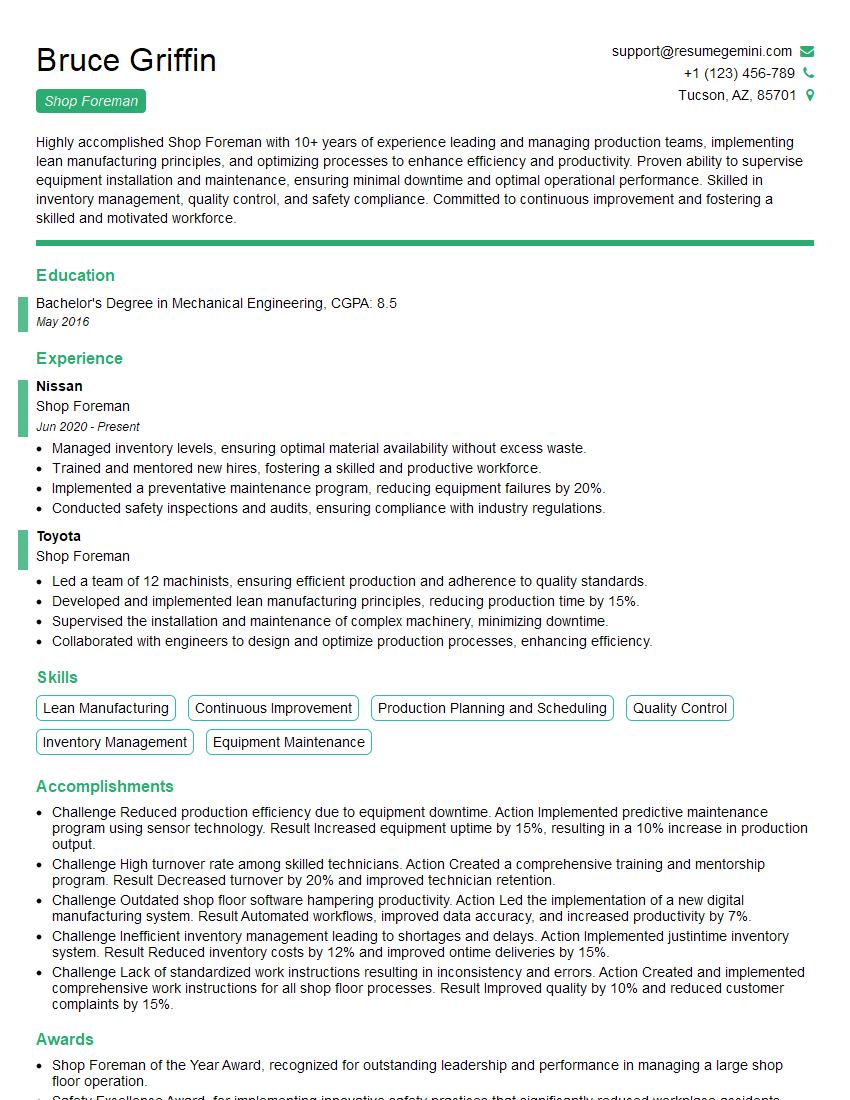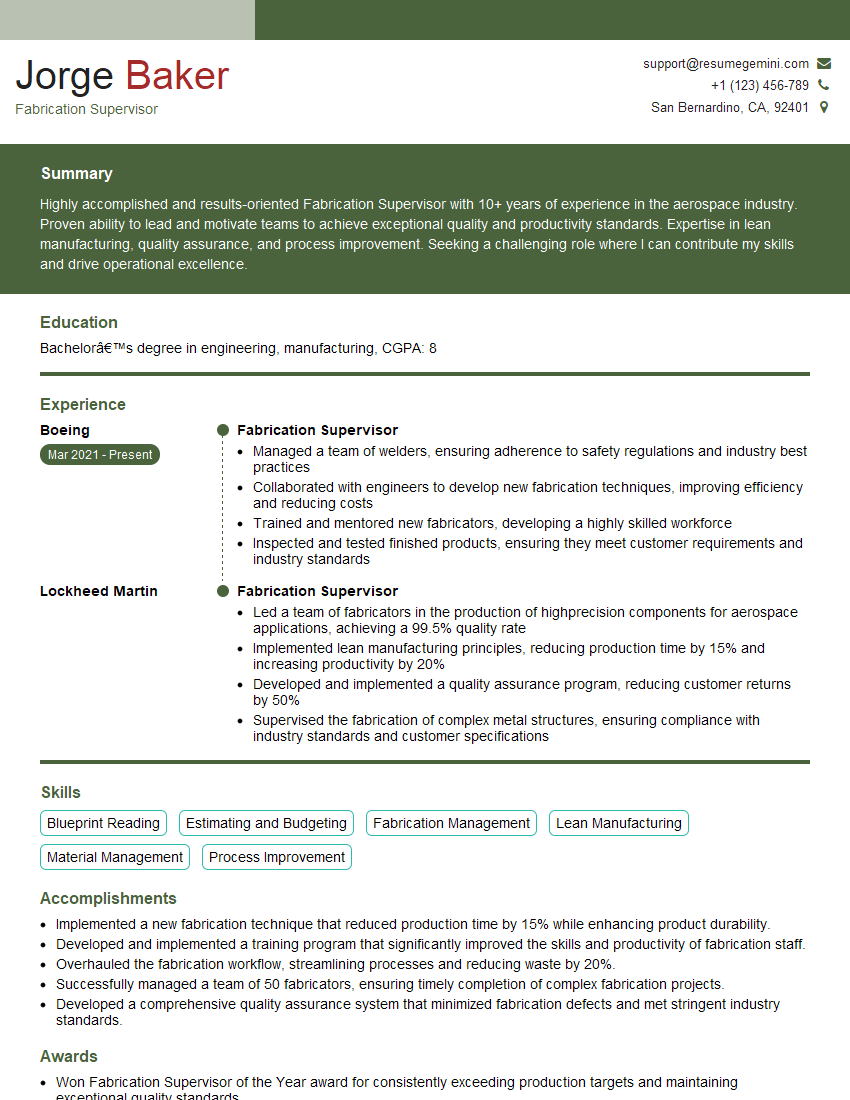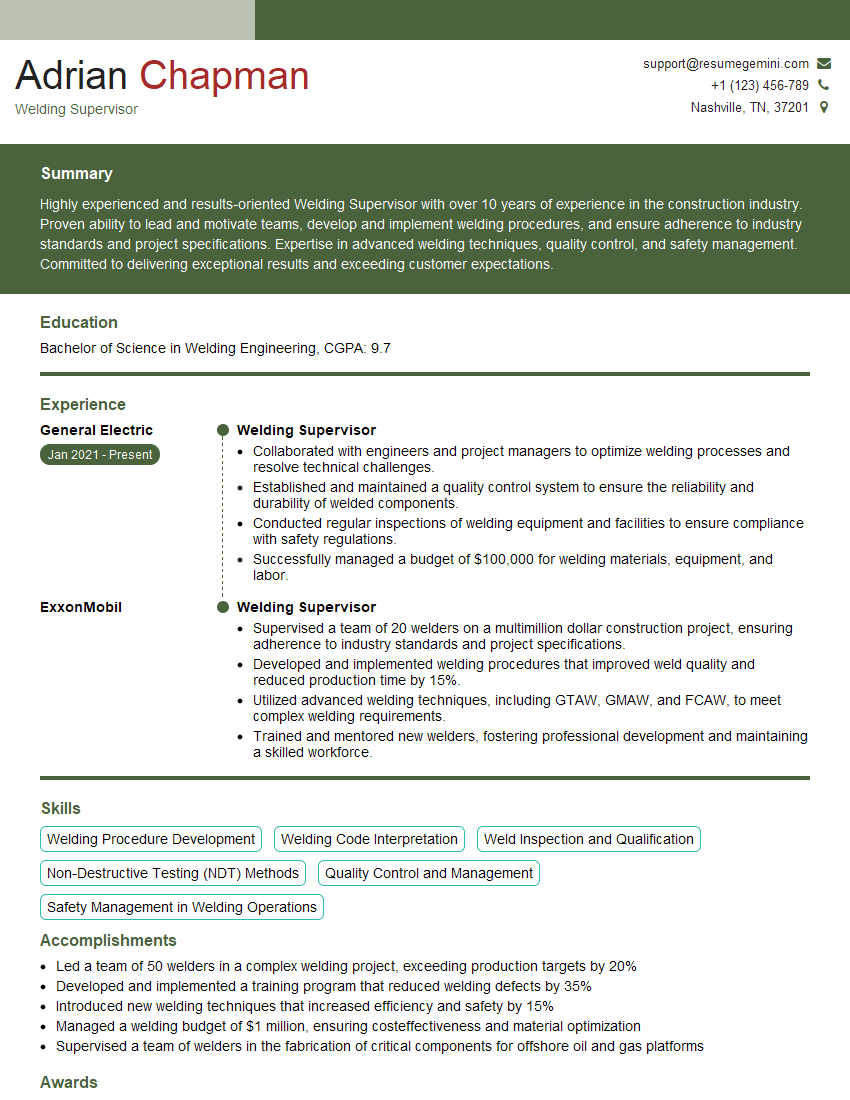Preparation is the key to success in any interview. In this post, we’ll explore crucial Steel Bending and Fabrication interview questions and equip you with strategies to craft impactful answers. Whether you’re a beginner or a pro, these tips will elevate your preparation.
Questions Asked in Steel Bending and Fabrication Interview
Q 1. Explain the different types of steel used in fabrication.
The choice of steel in fabrication depends heavily on the project’s requirements for strength, weldability, corrosion resistance, and cost. Several types are commonly used:
- Mild Steel (Low Carbon Steel): This is the most common type, offering a good balance of strength and weldability at a relatively low cost. It’s ideal for general construction and fabrication where high strength isn’t paramount. Think of it as the ‘workhorse’ of steel fabrication.
- High-Strength Low Alloy (HSLA) Steel: These steels offer significantly higher strength than mild steel for the same weight, making them excellent for applications where weight reduction is crucial, like in automotive or aerospace industries. They’re often more expensive but provide greater efficiency.
- Stainless Steel: Known for its exceptional corrosion resistance, stainless steel is used in applications exposed to harsh environments, like chemical plants or marine structures. Different grades exist, with varying chromium and nickel content, affecting strength and cost.
- Tool Steel: These are very hard and wear-resistant steels used for making tools and dies. They’re not as commonly used in large-scale structural fabrication but are essential for creating the equipment used in the process.
- Alloy Steels: A broad category, alloy steels are created by adding elements like chromium, nickel, molybdenum, or vanadium to improve specific properties like strength, toughness, or hardenability. The precise alloying elements determine the final properties and application.
Choosing the right steel is critical for project success. A mismatched steel can lead to structural failure or increased costs due to corrosion or premature wear.
Q 2. Describe the process of bending steel using different methods (e.g., hand bending, press brake).
Steel bending techniques vary depending on the material’s thickness, desired radius, and production volume. Here are a few common methods:
- Hand Bending: For smaller, thinner sections, hand bending using tools like a pipe bender or a hand brake is suitable. This method is labor-intensive and less precise for larger quantities. Imagine shaping a small metal rod for a custom railing – hand bending might be appropriate.
- Press Brake Bending: For larger volumes and thicker materials, a press brake is the most efficient and precise method. This machine uses a powerful hydraulic ram to bend the steel between a punch and die. The angle and depth of the bend are precisely controlled by adjusting the machine’s settings. Large-scale production of metal components, like car parts or building sections, heavily relies on press brakes.
- Roll Bending: Used for bending large diameter sections or long sheets of steel into curves or coils. Roll bending creates smooth, consistent bends with large radii, often used in constructing large tanks or pipes. Think of shaping large sheets into a cylindrical form.
- Rotary Draw Bending: This specialized method is used for creating tight radius bends without wrinkling or cracking the material, often employing a mandrel within the bend to maintain consistency.
Each method has its strengths and limitations, and selecting the appropriate method is vital for efficient and accurate bending.
Q 3. What safety precautions are crucial when working with steel bending and fabrication equipment?
Safety is paramount in steel bending and fabrication. Ignoring safety protocols can lead to severe injury or even fatalities. Crucial precautions include:
- Proper Personal Protective Equipment (PPE): This includes safety glasses, gloves, hearing protection, steel-toed boots, and sometimes a face shield depending on the process. Never compromise on PPE.
- Machine Guarding: All machinery should have appropriate guards in place to prevent accidental contact with moving parts. Regularly inspect these guards for damage or wear.
- Lockout/Tagout Procedures: Before any maintenance or repair on machinery, it must be properly locked out and tagged out to prevent accidental startup.
- Safe Lifting Practices: Use appropriate lifting equipment like cranes or hoists for heavy materials and adhere strictly to weight limits. Avoid manual lifting of excessively heavy materials.
- Fire Safety: Welding and cutting processes can generate sparks and hot metal, posing a significant fire hazard. Have fire extinguishers readily available and implement fire prevention measures. Proper ventilation is also critical.
- Environmental Considerations: Proper ventilation and dust extraction are essential to mitigate health risks associated with welding fumes and airborne particles.
Regular safety training and adherence to company safety policies are essential to maintain a safe working environment.
Q 4. How do you ensure the accuracy and precision of steel bending?
Ensuring accuracy and precision in steel bending involves a multi-faceted approach:
- Precise Measurements and Markings: Accurate measurements are fundamental. Use appropriate measuring tools (tape measures, calipers, etc.) and clearly mark the bending points on the steel.
- Proper Machine Setup: For press brakes, ensure the correct die and punch are selected and properly aligned. The machine’s settings, such as bending angle and depth, must be accurately calibrated.
- Material Selection: Choosing the correct grade of steel is crucial. Using a steel with improper properties could lead to inaccuracies or failures during bending.
- Use of Jigs and Fixtures: For repeatable accuracy, particularly in high-volume production, jigs and fixtures help hold the steel in place during bending, ensuring consistent results.
- Regular Maintenance: Regular maintenance of bending equipment ensures that it’s operating accurately and reliably. This helps prevent errors caused by worn or damaged parts.
- Quality Control Checks: Regularly inspect the bent steel to verify that it meets the required specifications. This might involve using measuring tools or checking against templates.
Implementing these steps will minimize errors and produce high-quality, precise bends consistently.
Q 5. What are common defects found in steel bending and fabrication, and how are they addressed?
Several common defects can occur during steel bending and fabrication:
- Wrinkling: This occurs when the material compresses excessively on the inside radius of the bend, often in thicker materials. It’s addressed by using a wider die or by reducing the bend radius.
- Springback: After bending, the material tends to partially return to its original shape. This is compensated for by over-bending slightly. Careful calculations and experience are vital here.
- Cracking: This is caused by exceeding the material’s yield strength during bending, often due to an excessively tight bend radius or using inappropriate material. Selection of correct steel and bend radius is key.
- Inconsistent Bending Angles: Variations in bending angles often stem from improper machine setup or inconsistent material thickness. Regular calibration and material inspection are critical.
- Dimensional Inaccuracies: Errors in measuring or marking can lead to parts being outside specified tolerances. Using precise measuring tools and templates helps mitigate this.
Addressing defects requires understanding their root cause. Proper preventative measures and quality control procedures minimize defects and ensure consistent product quality.
Q 6. Explain your experience with different types of welding techniques relevant to steel fabrication.
My experience encompasses various welding techniques relevant to steel fabrication:
- Shielded Metal Arc Welding (SMAW or Stick Welding): A versatile process suitable for various steel types and thicknesses, ideal for outdoor work where portability is important. I’m proficient in selecting the correct electrode type based on the base metal and application.
- Gas Metal Arc Welding (GMAW or MIG Welding): A high-speed process excellent for thin to medium-thickness steels. My expertise lies in adjusting parameters like voltage, wire feed speed, and shielding gas to achieve high-quality welds.
- Gas Tungsten Arc Welding (GTAW or TIG Welding): A precision process producing high-quality, aesthetically pleasing welds. I’m experienced in using this technique for joining thin sections, stainless steel, and applications requiring exceptional weld integrity.
- Flux-Cored Arc Welding (FCAW): A robust process suitable for outdoor use and capable of welding thicker sections. My experience includes choosing the appropriate flux-cored wire for various applications.
Selecting the optimal welding technique depends on factors like material thickness, joint design, accessibility, and required weld quality. My ability to choose and effectively execute the appropriate method is crucial for producing high-quality welds.
Q 7. How do you interpret and follow blueprints and fabrication drawings?
Interpreting and following blueprints and fabrication drawings is a fundamental skill for any steel fabricator. My process is methodical:
- Reviewing the Drawings Thoroughly: I begin by carefully reviewing the drawings, paying close attention to dimensions, tolerances, material specifications, and weld symbols. This stage is crucial to avoid errors later.
- Understanding the Design Intent: It’s not enough to just read the dimensions; I also analyze the design to understand the overall function of the component and how different parts interact. This helps identify potential issues early.
- Creating a Fabrication Plan: Based on the drawings and my understanding of the process, I develop a detailed fabrication plan, outlining the steps involved, the sequence of operations, and the required tools and equipment.
- Checking for Conflicts and Potential Issues: Before starting fabrication, I meticulously check the drawings for any potential conflicts or issues, like dimensional errors or ambiguous instructions. This preventative step is vital.
- Utilizing Appropriate Software (if applicable): For complex projects, I utilize CAD software to help visualize the components and ensure that everything fits together correctly before beginning fabrication.
Accurate interpretation and careful planning based on blueprints are key to successful fabrication projects, minimizing errors and ensuring the final product meets specifications.
Q 8. Describe your experience with various steel measuring and marking tools.
Accurate measurement and marking are fundamental to successful steel bending and fabrication. Over the years, I’ve become proficient with a range of tools, each suited to different tasks and precision levels.
Tape Measures: Essential for initial measurements and overall project planning. I rely on durable, high-quality tapes with clear markings for accuracy.
Steel Rules: For more precise short-distance measurements, especially when marking out cuts and bends. I often use hardened steel rules to prevent wear and tear.
Scribers: These create fine, accurate lines on the steel surface. I use them for marking cut lines, bend lines, and other critical dimensions. The sharpness of the scriber is crucial for visibility and accuracy.
Marking Gauges: Used to consistently mark repetitive measurements, improving efficiency and ensuring uniformity. This is particularly important when dealing with multiple identical components.
Chalk Lines: Useful for longer, straight lines, especially when laying out large components. This helps in the efficient transfer of dimensions.
Digital Calipers: Provide highly precise measurements, especially important for intricate work or when tolerances are tight. I use these for verifying measurements and ensuring accuracy before cutting or bending.
Choosing the right tool for each job is crucial. For example, while a tape measure might suffice for initial layouts, precise cutting requires a steel rule and scriber for exact marking to avoid costly errors.
Q 9. How do you handle material waste during the steel bending and fabrication process?
Minimizing material waste is a crucial aspect of efficient and cost-effective steel fabrication. My approach focuses on meticulous planning and optimized cutting strategies.
Detailed Planning: Before cutting, I meticulously review the blueprints and create optimized cutting patterns using CAD software to maximize material utilization. This minimizes waste from the outset.
Nesting Software: We utilize nesting software, which automatically arranges parts on a sheet to minimize waste. This software considers various factors, including material size, part shapes, and orientation to optimize cutting.
Offcuts Management: We maintain an organized system for storing offcuts. Smaller pieces are often repurposed for smaller projects or used to create templates, preventing total waste.
Scrap Recycling: All scrap metal is properly sorted and recycled, reducing environmental impact and potentially providing a revenue stream.
Continuous Improvement: We regularly review our cutting processes to identify areas for improvement and reduce waste further. This might involve adopting new software, changing cutting techniques, or adjusting our work layout.
For example, in one project involving intricate brackets, we optimized our nesting algorithm, reducing material waste by 15% and saving the company considerable money.
Q 10. Explain your experience with different types of steel cutting techniques.
My experience encompasses various steel cutting techniques, each with its own advantages and applications:
Oxy-Fuel Cutting: Ideal for thicker steel sections, it offers high cutting speeds and relatively low equipment cost. However, it produces a wider heat-affected zone (HAZ) requiring post-processing.
Plasma Cutting: Provides a narrower kerf (cut width) and better edge quality than oxy-fuel cutting, making it suitable for more precise work. It’s more efficient for thinner materials.
Laser Cutting: The most precise method, offering exceptional accuracy and smooth edges. Ideal for intricate designs and high-volume production. It’s also a very clean and efficient method.
Shearing: A cost-effective method for straight cuts on relatively thin sheet metal. It produces a clean cut with minimal material waste.
Abrasive Waterjet Cutting: Suitable for cutting almost any material, including very hard or brittle materials, with minimal heat distortion. This method is highly versatile but can be slower than other methods.
The choice of method depends heavily on the material thickness, desired accuracy, and production volume. In my work, I often select the technique that provides the best balance of cost-effectiveness, speed, and quality.
Q 11. How do you ensure quality control throughout the fabrication process?
Quality control is integrated throughout our steel fabrication process. It’s not just a final check; it’s a continuous monitoring system.
Material Inspection: We begin by inspecting incoming steel for defects such as cracks, pitting, or inconsistent thickness. This ensures we are working with quality materials.
Dimensional Verification: At each stage, we use precise measuring tools to verify that dimensions conform to specifications. This includes checking cuts, bends, and welds.
Welding Inspection: Welds are visually inspected and sometimes subjected to non-destructive testing (NDT) methods like radiography or ultrasonic testing to detect internal flaws.
Regular Calibration: All measuring equipment is regularly calibrated to ensure accuracy and reliability of measurements.
Documentation: Meticulous records are kept at each step of the fabrication process, including material certifications, inspection reports, and any deviations from the plan.
Process Audits: Regular internal audits are conducted to review our quality control procedures and identify areas for improvement. This ensures continuous improvement of our processes.
Our commitment to quality control ensures we deliver products that meet or exceed customer expectations and industry standards. For example, we recently implemented a new welding inspection procedure that reduced the defect rate by 10%.
Q 12. Describe your experience with different types of steel finishing techniques.
Steel finishing techniques enhance the appearance, durability, and corrosion resistance of the fabricated components. My experience includes:
Painting: A common method providing both protection and aesthetics. We use various types of paints, chosen based on the specific application and environmental conditions. Proper surface preparation is crucial for a durable finish.
Powder Coating: Offers superior durability and a wide range of colors compared to liquid paints. It provides excellent protection against corrosion.
Galvanizing: A cost-effective method for providing corrosion resistance by dipping the steel into molten zinc. It’s particularly effective for outdoor applications.
Zinc-rich Primers: Applied before painting, these primers enhance corrosion protection, particularly in aggressive environments.
Shot Blasting: A surface preparation technique that removes mill scale, rust, and other imperfections, creating a better surface for painting or other finishes.
The choice of finishing technique depends on factors such as the application environment, budget, and desired aesthetic appearance. We always ensure the finish chosen meets the necessary requirements for the intended use.
Q 13. How do you troubleshoot problems encountered during steel bending and fabrication?
Troubleshooting in steel bending and fabrication requires a systematic approach. I typically follow these steps:
Identify the Problem: Precisely define the issue. Is it a dimensional inaccuracy, a weld defect, or a problem with the finish? Gather all relevant information.
Analyze the Cause: Investigate potential root causes. Was it a measurement error, a machine malfunction, a problem with the materials, or an incorrect process setting?
Develop Solutions: Based on the root cause analysis, develop possible solutions. This may involve recalibrating equipment, adjusting process parameters, or replacing faulty materials.
Implement and Test: Implement the chosen solution and test its effectiveness. Document the results and make any necessary adjustments.
Prevent Recurrence: Once the problem is resolved, implement measures to prevent it from happening again. This might involve improving training, modifying work procedures, or upgrading equipment.
For example, when encountering consistently inaccurate bends, I’ve systematically checked the bending machine’s calibration, die condition, and material properties to identify the root cause, ultimately resolving the issue through recalibration and die replacement.
Q 14. Explain your experience with using CAD software for steel fabrication.
CAD software is integral to modern steel fabrication, significantly improving efficiency and accuracy. My experience includes using various CAD packages, including AutoCAD and SolidWorks.
Design and Modeling: I use CAD software to create detailed 3D models of steel components and assemblies. This allows for visualization, design optimization, and precise dimensioning.
Cutting Optimization: CAD software facilitates the creation of optimized nesting patterns for sheet metal, minimizing material waste and improving productivity.
Blueprint Generation: CAD software generates accurate and detailed blueprints, ensuring consistency and clarity during fabrication.
Collaboration and Communication: CAD models can be easily shared with clients and other team members, improving communication and ensuring everyone is on the same page.
Simulation and Analysis: Some advanced CAD software allows for stress analysis and simulation, enabling engineers to design stronger, more efficient structures.
CAD software has drastically reduced errors and improved the overall quality of our steel fabrications. For instance, in a recent project involving complex curved structures, CAD modeling helped us identify and correct potential design flaws early in the process, avoiding costly rework.
Q 15. How do you calculate the required material for a specific fabrication project?
Calculating material requirements for steel fabrication projects involves a systematic approach. It starts with detailed engineering drawings that specify dimensions, quantities, and types of steel sections required. Then, we use these drawings to create a comprehensive bill of materials (BOM). This BOM meticulously lists each steel component, its dimensions (length, width, thickness), and the quantity needed. For each component, I calculate the linear meterage of the steel required, taking into account any waste or cut-offs during the fabrication process. This waste factor varies based on the complexity of the design and the cutting methods used. For example, a project involving many complex curves will inherently have more waste than one with mostly straight cuts. I typically add a 5-10% buffer to the total material quantity to account for unexpected issues or minor errors.
Let’s consider a simple example: We need 100 I-beams, each 6 meters long. The total length needed would be 600 meters. But if we assume a 10% waste factor, we would actually order 660 meters of I-beam material (600 * 1.10).
Software like AutoCAD or specialized steel detailing programs automates much of this calculation, but a deep understanding of the project’s design and the fabrication process remains crucial for accurate material estimation.
Career Expert Tips:
- Ace those interviews! Prepare effectively by reviewing the Top 50 Most Common Interview Questions on ResumeGemini.
- Navigate your job search with confidence! Explore a wide range of Career Tips on ResumeGemini. Learn about common challenges and recommendations to overcome them.
- Craft the perfect resume! Master the Art of Resume Writing with ResumeGemini’s guide. Showcase your unique qualifications and achievements effectively.
- Don’t miss out on holiday savings! Build your dream resume with ResumeGemini’s ATS optimized templates.
Q 16. Describe your experience working with different types of steel joining methods.
Throughout my career, I’ve worked extensively with various steel joining methods, each suited to different applications and structural requirements. Some common methods include:
- Welding: This is a prevalent technique, encompassing various types like Shielded Metal Arc Welding (SMAW), Gas Metal Arc Welding (GMAW), and Tungsten Inert Gas Welding (TIG). SMAW is robust and versatile but requires skilled welders, while GMAW is faster for mass production. TIG welding offers precise control for high-quality welds but is slower. The choice depends on factors like weld strength requirements, material thickness, and access to equipment and skilled personnel. I’ve used all three extensively in the past and am proficient in interpreting weld symbols and ensuring the welds meet the required codes and standards.
- Bolting: High-strength bolts are employed for connections requiring easy disassembly or where welding might be impractical. Proper torque control is critical to ensure sufficient clamping force. I’m very familiar with different bolt grades and their specifications, ensuring that we use the correct grade based on the load requirements. Bolting is commonly used in situations requiring regular maintenance or where ease of assembly and disassembly is a priority.
- Riveting: While less common in modern fabrication, riveting remains relevant in specific situations where welding isn’t feasible or where high vibration resistance is needed. This method offers exceptional durability and stability, particularly for structures exposed to extreme conditions. I have experience working with rivets in more traditional construction methods.
My experience includes ensuring each connection method adheres to safety regulations and design specifications, always prioritizing structural integrity and quality control. Selecting the appropriate joining method involves a careful assessment of project requirements, cost-effectiveness, and potential limitations.
Q 17. How do you maintain and clean steel fabrication equipment?
Maintaining and cleaning steel fabrication equipment is crucial for safety, efficiency, and the longevity of the equipment. My approach involves a multi-faceted strategy:
- Regular Cleaning: After each use, I clean equipment to remove debris, welding spatter, and metal chips. This prevents buildup that can interfere with operation and potentially cause accidents. Specific cleaning methods vary based on the type of equipment. For example, welding machines require careful cleaning of the contact points to ensure proper electrical conductivity. Cutting equipment often has specific procedures for removing material from blades.
- Lubrication: Moving parts of machinery, such as bending rolls or shears, require regular lubrication to reduce friction, wear, and tear. Using appropriate lubricants ensures smooth operation and prevents premature failure.
- Inspection: Regular visual inspections are critical for identifying potential problems such as worn parts, loose fasteners, or damaged components. I report any findings to the supervisor promptly, preventing potential accidents or costly downtime.
- Preventative Maintenance: This includes scheduled servicing, including replacing worn parts, calibrating measuring tools, and ensuring safety mechanisms are functioning correctly. Following a structured preventative maintenance plan dramatically reduces repair costs and ensures the equipment’s long-term performance.
Safe handling and storage of equipment are also paramount, particularly in a busy workshop environment. Proper organization prevents collisions and damage, maximizing efficiency and safety.
Q 18. Explain your understanding of different steel alloys and their properties.
Understanding steel alloys and their properties is fundamental to successful steel fabrication. Different alloys exhibit varied characteristics affecting their suitability for specific applications. Some key alloys include:
- Carbon Steel: The most common type, characterized by its carbon content. Higher carbon content results in increased strength but reduced ductility. This is the common choice for many construction applications because of its versatility and cost-effectiveness.
- Alloy Steel: Contains added elements like chromium, nickel, molybdenum, or manganese to enhance specific properties such as strength, toughness, corrosion resistance, or weldability. Examples include stainless steel (high corrosion resistance) and high-strength low-alloy (HSLA) steel (high strength and weldability).
- Stainless Steel: Known for its corrosion resistance due to its high chromium content. Different grades of stainless steel exist, each offering varying levels of corrosion resistance, strength, and workability. This is especially relevant for applications exposed to the elements or harsh chemicals.
When choosing the correct steel alloy, I consider factors such as the intended use, the required strength, the environment the steel will be exposed to, weldability requirements, and budgetary constraints. This knowledge is crucial to selecting the most appropriate and cost-effective material for any given project, ensuring the structure’s longevity and performance. For example, we would use stainless steel for a coastal structure to withstand corrosion and high-strength steel for a structure requiring high load-bearing capacity.
Q 19. How do you manage time effectively in a fast-paced steel fabrication environment?
Effective time management in a fast-paced steel fabrication environment is critical. My approach centers around several key strategies:
- Prioritization: I identify critical tasks and prioritize them based on deadlines and project requirements. This involves understanding the project sequencing and identifying potential bottlenecks.
- Planning and Scheduling: I utilize project management tools or simply detailed checklists to schedule tasks, allocating time effectively and considering potential delays. This often involves collaboration with the project manager to ensure alignment and resource availability.
- Efficient Workflow: Optimizing the workflow within the team minimizes wasted time and improves overall productivity. This might involve streamlining processes, improving material handling, and ensuring clear communication.
- Delegation: When appropriate, I delegate tasks to team members to maximize efficiency, making sure everyone has the required skills and information to complete their allocated responsibilities.
- Problem-Solving: Addressing unforeseen issues quickly and effectively minimizes disruptions and delays. Having contingency plans in place helps to quickly resolve these issues.
Maintaining focus and discipline is vital; I use techniques like timeboxing for specific tasks and regular breaks to prevent burnout, thereby consistently ensuring high quality of work even in high-pressure environments.
Q 20. Describe your experience working as part of a team in a steel fabrication setting.
Teamwork is essential in steel fabrication. In my experience, effective collaboration hinges on clear communication, mutual respect, and shared responsibility. I’ve worked on numerous projects involving teams of varying sizes and skill sets. My role often involves mentoring junior fabricators, providing guidance on techniques, and ensuring safety standards are met. I’ve actively participated in team meetings, contributing ideas, offering feedback, and collaborating on problem-solving. I value open communication where everyone feels comfortable contributing ideas and raising concerns. Constructive criticism and feedback are essential parts of the process and significantly enhance the quality of the final product.
In one project, involving the fabrication of a large structural frame, our team encountered a problem with a complex weld sequence that was delaying the project. Through open discussion and brainstorming, the team identified an alternative method, substantially improving the efficiency of the process. This success hinged on our commitment to teamwork and mutual problem-solving.
My approach always prioritizes fostering a positive and productive team environment, where everyone feels valued and empowered to contribute to the success of the project.
Q 21. How do you ensure the structural integrity of fabricated steel components?
Ensuring the structural integrity of fabricated steel components is paramount and involves a multi-stage approach. It begins with adhering strictly to engineering drawings and specifications. This includes verifying material selection, dimensions, and weld specifications. Proper material handling and storage are also critical to prevent damage during fabrication. Throughout the fabrication process, regular quality control checks are performed, including visual inspections, dimensional checks, and in some cases, non-destructive testing (NDT) such as ultrasonic testing or radiographic testing to detect potential flaws. The quality of welds is rigorously checked to ensure they meet the required standards. This involves verifying weld penetration, reinforcement, and the absence of defects.
After fabrication, the components often undergo further testing and inspection, depending on the project’s criticality. This might involve load testing to verify the component’s ability to withstand expected stresses and strains. Maintaining detailed records of materials used, processes followed, and test results ensures traceability and accountability. Following established safety regulations and adhering to relevant codes and standards (e.g., AWS D1.1 Structural Welding Code) are paramount, minimizing risks and guaranteeing that the fabricated structure is structurally sound and safe.
Ultimately, responsibility for structural integrity is a shared one, starting from design and ending with final inspection. My commitment is to diligently perform my part, contributing to the delivery of safe and reliable steel structures.
Q 22. How do you address conflicting priorities in steel fabrication projects?
Conflicting priorities in steel fabrication are common, often involving competing demands for time, budget, and quality. My approach is systematic and relies on clear communication and prioritization. First, I’d conduct a thorough review of all project requirements, identifying potential conflicts early. This involves careful analysis of the design specifications, material availability, and client expectations.
Then, I utilize a prioritization matrix, often using a weighted scoring system, to rank the various objectives. Factors such as project deadlines, safety regulations, and client satisfaction are carefully weighed. This allows for a data-driven approach, ensuring that the most critical aspects are addressed first. Open communication with all stakeholders – clients, engineers, and the fabrication team – is crucial. Transparency about potential trade-offs and collaborative decision-making are essential for finding acceptable compromises. For example, if a tight deadline conflicts with meticulous quality control, we might prioritize critical structural elements first, while scheduling less crucial elements for later, potentially with adjustments to the overall project timeline communicated and agreed upon with the client.
Q 23. Describe your experience working with various types of steel profiles.
My experience spans a wide range of steel profiles, including:
- I-beams: Widely used for structural support in buildings and bridges, I’m proficient in handling various sizes and grades of I-beams, from fabrication to installation considerations.
- H-beams: Similar to I-beams but with wider flanges, often chosen for heavy-duty applications; I understand their unique bending characteristics and appropriate fabrication techniques.
- Channels: Used for supporting loads and creating frameworks; I’m experienced in working with different channel sizes and incorporating them into complex assemblies.
- Angles: Versatile profiles used for bracing, framing, and connections; I’m familiar with various angle types and their applications in different structural designs.
- Round and Square Tubing: Commonly used for railings, handrails, and decorative elements; I understand the nuances of bending these profiles to maintain structural integrity while achieving aesthetic requirements.
I am also familiar with specialized profiles and can adapt my techniques accordingly. Experience with diverse profiles ensures I can select the best option for a given application, considering factors such as strength, weight, and cost-effectiveness.
Q 24. Explain your understanding of different types of steel bending machines.
My understanding of steel bending machines encompasses various types, each suited to specific applications and material properties:
- Press Brakes: Primarily used for bending sheet metal and plate steel into precise angles. They offer excellent control and repeatability, making them ideal for high-volume production of standardized components.
- Roll Bending Machines: Designed for bending larger profiles, such as pipes, tubes, and beams, into curves or coils. Different types exist (e.g., three-roll, four-roll) each offering unique capabilities in terms of bending radius and material thickness.
- CNC Press Brakes: Computer numerically controlled press brakes offer increased precision and automation, enabling complex bending sequences with minimal human intervention. Programming and operation of such machines requires specialized skills, which I possess.
- Manual Bending Machines: Simpler, hand-operated machines suitable for smaller projects or specific tasks. I understand their limitations and when they are appropriately utilized.
Choosing the right machine depends on the project’s scale, the type of steel profile, and the desired bending accuracy. My expertise allows for optimal machine selection and efficient operation to ensure quality and timely project completion.
Q 25. How do you ensure compliance with safety regulations and industry standards?
Safety and compliance are paramount in steel fabrication. My approach is proactive, encompassing all stages from design to completion. This involves:
- Strict adherence to OSHA (or relevant regional) safety regulations: This includes proper use of personal protective equipment (PPE), safe machine operation, and maintaining a clean and organized workspace.
- Regular safety training and refresher courses: Keeping up-to-date with best practices and emerging safety technologies is a continuous process.
- Implementing comprehensive safety procedures: These procedures cover risk assessment, hazard identification, and mitigation strategies for all aspects of the fabrication process.
- Regular equipment inspection and maintenance: Preventing malfunctions and ensuring machinery is in optimal working condition is crucial for worker safety.
- Thorough quality control: This involves inspecting raw materials, intermediate products, and finished goods to ensure they meet quality and safety standards.
I am familiar with relevant industry standards like AWS D1.1 (Structural Welding Code – Steel) and ensure all work is compliant. Safety isn’t just a checklist; it’s an integral part of my professional ethos.
Q 26. Describe your experience with project planning and scheduling in steel fabrication.
Project planning and scheduling are critical to efficient and successful steel fabrication. My approach involves a phased approach:
- Detailed project scope definition: This includes a thorough review of blueprints, specifications, and material requirements.
- Work breakdown structure (WBS): Breaking down the project into manageable tasks, assigning responsibilities, and establishing clear timelines.
- Resource allocation: Determining the necessary manpower, equipment, and materials, factoring in potential delays or resource constraints.
- Critical path analysis: Identifying the sequence of tasks that directly impact the overall project duration, allowing for proactive management of potential bottlenecks.
- Scheduling software utilization: Employing project management software (like MS Project or similar) to create and track schedules, monitor progress, and manage resources efficiently.
I’ve successfully managed projects using these techniques, leading to timely delivery and within budget. Regular monitoring and adjustments are crucial, particularly when faced with unexpected events.
Q 27. How do you handle unexpected challenges or delays during a steel fabrication project?
Unexpected challenges are inevitable in steel fabrication. My response involves a structured approach:
- Immediate assessment: Quickly identify the nature and scope of the challenge (e.g., material delay, equipment malfunction, design revision).
- Impact analysis: Evaluate the potential consequences on the project timeline, budget, and quality.
- Problem-solving: Develop and implement solutions; this might involve finding alternative materials, adjusting the schedule, or seeking expert advice.
- Communication: Keep stakeholders informed of the situation, proposed solutions, and any potential impact on the project.
- Documentation: Maintaining a detailed record of the challenge, the adopted solution, and its impact, enabling future learning and risk mitigation.
For example, I once encountered a significant material delay. By immediately communicating with the supplier and exploring alternative sources, we managed to minimize the project disruption, only experiencing a minor schedule slippage that was clearly communicated to the client and agreed upon.
Q 28. Describe a situation where you had to resolve a difficult technical problem related to steel bending or fabrication.
During a large-scale bridge project, we encountered a complex bending challenge involving a large, thick steel plate that required a very tight radius bend without cracking. Standard bending techniques were deemed insufficient to prevent material failure.
My solution involved a multi-step approach: First, we conducted finite element analysis (FEA) simulations to optimize the bending process and predict stress distribution. This guided us in selecting the most appropriate bending machine and developing a precise bending sequence. Second, we preheated the steel plate to improve its ductility and reduce the risk of cracking. Third, we employed a controlled incremental bending process, carefully monitoring the stress levels throughout the procedure. Finally, we implemented a post-bending stress-relieving process to further reduce residual stresses. The result was a successful bend, meeting all design specifications without any material failure. The successful resolution highlighted the importance of combining theoretical knowledge with practical experience and advanced technologies. This experience reinforced the need for careful planning, thorough analysis, and the application of innovative solutions to complex fabrication challenges.
Key Topics to Learn for Steel Bending and Fabrication Interview
- Material Properties: Understanding different steel grades (e.g., mild steel, high-strength steel), their tensile strength, yield strength, and ductility. This is crucial for selecting the appropriate material for a given project.
- Bending Processes: Familiarize yourself with various bending techniques (e.g., press brake bending, roll bending, cold bending, hot bending) and their applications. Be prepared to discuss the advantages and limitations of each method.
- Fabrication Techniques: Mastering welding (different types like MIG, TIG, arc welding), cutting (plasma cutting, oxy-fuel cutting, laser cutting), and other joining methods is essential. Understanding their strengths and weaknesses in various applications is key.
- Blueprint Reading and Interpretation: Demonstrate your ability to accurately read and interpret engineering drawings, including dimensions, tolerances, and specifications. This is fundamental to successful fabrication.
- Safety Procedures and Regulations: Highlight your knowledge of OSHA regulations and safety protocols related to steel bending and fabrication. This is a critical aspect of the job.
- Quality Control and Inspection: Understand various quality control methods used in the industry and be prepared to discuss how to identify and address defects in fabricated steel components.
- Troubleshooting and Problem-Solving: Be ready to discuss your approach to problem-solving in a fabrication setting, including identifying the root cause of issues and implementing effective solutions.
- Project Management Fundamentals: Even as a fabricator, understanding project timelines, resource allocation, and potential challenges will set you apart.
Next Steps
Mastering steel bending and fabrication opens doors to a rewarding career with excellent growth potential. This skillset is highly sought after in construction, manufacturing, and infrastructure development, offering opportunities for advancement and specialization. To maximize your job prospects, create an ATS-friendly resume that showcases your skills and experience effectively. ResumeGemini is a trusted resource that can help you build a professional and impactful resume. We provide examples of resumes tailored specifically to the steel bending and fabrication industry to guide you. Take the next step towards your dream job today!
Explore more articles
Users Rating of Our Blogs
Share Your Experience
We value your feedback! Please rate our content and share your thoughts (optional).
What Readers Say About Our Blog
Hi, I have something for you and recorded a quick Loom video to show the kind of value I can bring to you.
Even if we don’t work together, I’m confident you’ll take away something valuable and learn a few new ideas.
Here’s the link: https://bit.ly/loom-video-daniel
Would love your thoughts after watching!
– Daniel
This was kind of a unique content I found around the specialized skills. Very helpful questions and good detailed answers.
Very Helpful blog, thank you Interviewgemini team.
